





Published on Apr 02, 2024
Today only 2.7 billion people – a little more than one third of the world’s population—have Internet access. This fact can be attributed to many reasons, but the most important factor is the scarcity of intensive capital necessary for Internet infrastructure implementation in many developing areas. The rapid development in wireless telecommunication industry has boosted another revolution in data services. Even though there are more than 1 billion smartphone subscribers in the world, the majority of them still don’t have data access due to the costly data plan in many countries.
On the other hand, the vast majority of the prices people pay for data plans go directly towards covering the tens of billions of dollars spent each year building the infrastructure to deliver the connections. Unless the infrastructure expansion becomes more efficient, the industry cannot sustainably serve everyone. Bring majority of the global population into Internet community is one of the greatest challenges of our generation, and now we see hope from the Google Project Loon – a network of balloons traveling on the edge of space, designed to provide ubiquitous Internet connectivity free of terrestrial constrains and with an affordable rate worldwide.
Now the time is 2015, and the Google Project Loon finally matured in technology. The novel system is ready to enter the market to provide Broadband Internet connectivity. However, this industry is highly competitive and prospers with various Broadband technologies.
Project Loon balloons travel around 20 km above the Earth’s surface in the stratosphere. Winds in the stratosphere are generally steady and slow-moving at between 5 and 20 mph, and each layer of wind varies in direction and magnitude. Project Loon uses software algorithms to determine where its balloons need to go, then moves each one into a layer of wind blowing in the right direction. By moving with the wind, the balloons can be arranged to form one large communications network Situated between 10 km and 60 km altitude on the edge of space, the stratosphere is named after the different strata, or layers, of wind within it. But the extreme altitude also presents unique engineering challenges:
1. air pressure is 1% of that at sea level,
2. temperatures hover around -50°C, and
3. a thinner atmosphere offers less protection from the UV radiation and temperature swings caused by the sun’s rays.
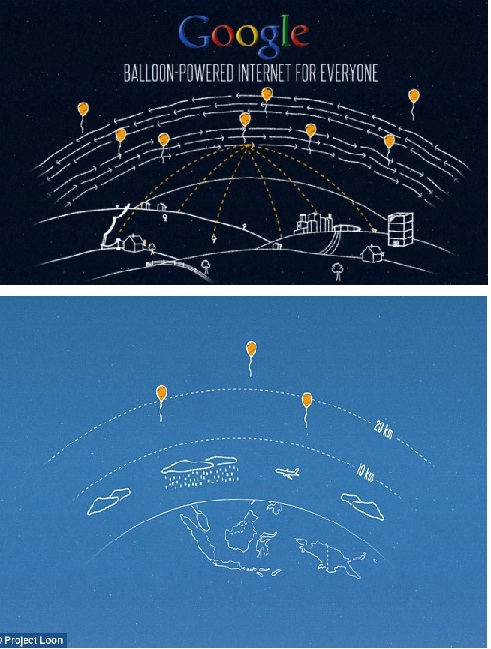
The loon is comprised of three parts: an envelope, solar panels and equipment.
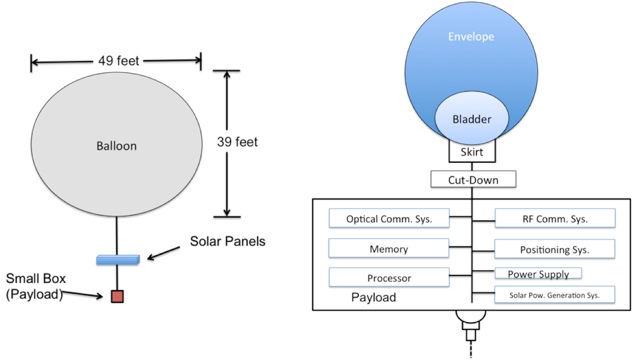
The balloon envelope is the name for the inflatable part of the balloon. Project Loon’s balloon envelopes are made from sheets of polyethylene plastic and stand fifteen meters wide by twelve meters tall when fully inflated.
They are specially constructed for use in super pressure balloons, which are longer lasting than weather balloons because they can withstand higher pressure from the air inside when the balloons reach float altitude. When a balloon is ready to be taken out of service, gas is released from the envelope to bring the balloon down in a controlled descent. In the unlikely event a balloon drops too quickly, we deploy the parachute attached to the top of the envelope.
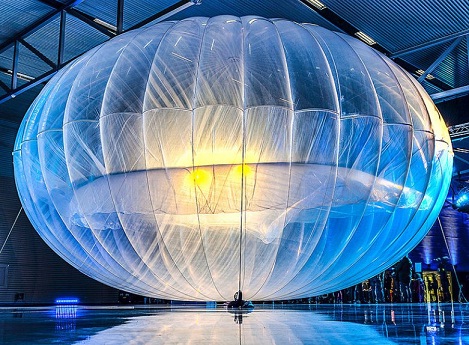
A small box containing the balloon’s electronic equipment hangs underneath the inflated envelope, like the basket that is carried by a hot air balloon.
This box contains circuit boards that control the system, radio antennas to communicate with other balloons and with Internet antennas on the ground, and batteries to store solar power so the balloons can operate during the night.
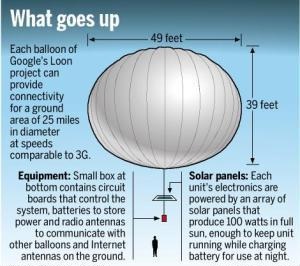
It can provide wireless Internet connectivity to ground areas at up to 10Mbps (3G speed). There are two kinds of communications: balloon-to-balloon network and balloon-to-ground station or subscribers network. It has specialized radio antennas to support two networks. It currently uses ISM bands specifically 2.4 and 5.8 GHz bands because they are typically unlicensed radio frequencies around the world, which means Google is able to avoid negotiating with local governments to purchase specific radio frequencies. Additionally, these also avoids interferences and reaches much further distances. Because it does not support Wi-Fi, smart phones such as iPhone are not able to establish connections directly to balloons. it requires users to install a specialized antenna the outside of their home to receive the signal from a balloon near their home and to decrypt the signal. This way is very similar to the usage of satellites.
A user with the specialized antenna sends signals via a radio frequency over ISM bands to a balloon close to him/her. The balloon sends the signals to neighboring balloons. Eventually, the signals reach the balloon which is connected to the local Internet. The wireless mesh network is constantly adjusting as balloons move. Any balloon is able to connect the Internet to a base station which has Internet connectivity and then receives Internet data and forwards them via balloons in the sky to the destination. Finally, the balloon close to the request user broadcasts the data to the grounds via a radio frequency over ISM bands. The special antenna installed the outside of home receives data and decrypt the data. The wireless mesh network should be constantly adjusting as balloons move.
It covers an area of an around 40 km (28 mi) diameter circle which is twice the area of New York City. Thousands of balloons can cover the whole world. Currently, its lifetime is only a few weeks, but Google anticipates that they can be in the sky hundreds of days in future.
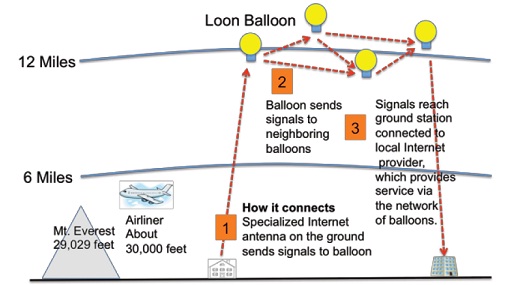
Far below the loons, ground stations providing connectivity to backbone Internet can transmit signals to the balloons up to 65 miles far. The signals would hop forward, from one balloon to the next, along a chain of up to 5 balloons. Each balloon is networked to one another within 30 miles with a radio transceiver as in a mesh, designed to ensure signal reliability. A second transceiver keeps the balloon in contact hundreds of antennas on ground area about 25 miles in diameter at speeds comparable to 3G. The specialized antennas can be placed on homes, much like a very small satellite TV receiver. Project Loon currently uses ISM bands (specifically 2.4 and 5.8 GHz bands) that are available for anyone to use. There is also a back-up transceiver and a GPS on each balloon, so Google can monitor each balloon's location.
Project Loon balloons travel around 65,000 feet above the Earth’s surface in the stratosphere. Winds in the stratosphere are generally steady and slow-moving at between 5 and 20 mph, and each layer of wind varies in direction and magnitude. Due to the wind properties, balloons can travel along latitude line with a ± 5o latitude range. Project Loon uses software algorithms to determine where its balloons need to go, then moves each one into a layer of wind blowing in the right direction. By moving with the wind, the balloons can be arranged to form one large communications network. The Loon team can access the web-based control system from any computer or tablet.
Lower Cost
Availability of Information
Education
Health and Medicine
Use of Renewable Energy
Weather Surveillance
Collaboration
Hardware Failure
internet privacy
Not a replacement of satellite communication.
International politics
Google's vision for Project Loon procures schooling for those currently without education, brings doctors for people who cannot travel to see one, and provides important weather data to assist farmers, whose harvests are affected by droughts and floods.
Illiteracy, Disease and Famine could be dealt a swift and telling blow with a little Wi-Fi and according to Team Loon, balloons stationed so high above the earth they can only be seen with a telescope, is the most affordable and best way to achieve this.
"The materials are pretty inexpensive," says Project Loon's Richard DeVaul. "The plastic of the balloons is similar to that in shopping bags and the electronics aren't that different from consumer electronics. This is a very cost-effective way to connect the world."
There is near about 75% comment is in the favor of project loons. As per the experts there would be great Success for this Project in Future. And we hope balloons could become an option for connecting rural, remote, and underserved areas, and for helping with communications after natural disasters.
[1] A. K Jain, K Nandakumar, and A Nagar, “Biometric Template Security,” 2008, ACM, , DO l.10.1155/2008/579416.
[2] http://biometrics.pbworks.com/f/comparisontable.png Last seen 02 Sept 2017
| Are you interested in this topic.Then mail to us immediately to get the full report.
email :- contactv2@gmail.com |